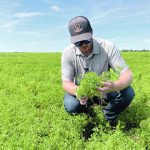Active ingredient could help producers fight anthracnose, mycosphaerella and ascochyta in pulse crops
"This solution was developed specifically for this market, at BASF research farms, and has proven performance on major pulse diseases regardless of a pathogen's resistance status," said Sylvain Mialon, brand manager, fungicides, cereals & pulses at BASF.Tag Archives fungicide — page 2

Should I spray or should I go?
Deciding on a fungicide application to control mycosphaerella blight (aka ascochyta blight) in field peas can be difficult. Many variables are at play, including disease occurrence, product selection, application timing, single versus double treatments, application costs and potential returns on investment. To help, a fungicide decision worksheet is available to take some of the guesswork […] Read more

Slow down, up the volume, reduce the pressure
A spraying specialist weighs in on how producers can achieve effective deep canopy coverage while applying fungicides
In Agrimetrix research conducted in chickpeas and field peas, water volume was the most important factor associated with good canopy penetration.
New fungicide tackles resistance in pulses
Kirsten Ratzlaff of Corteva said the company’s new active ingredient, adavelt, is a florylpicoxamid/FRAC group 21 and the first broad-spectrum picolinamide fungicide for use against ascomycota pathogens.

New fungicide for lentils, peas and chickpeas
"This solution was developed specifically for this market, at BASF research farms, and has proven performance on major pulse diseases regardless of a pathogen's resistance status," said Sylvain Mialon, brand manager, fungicides, cereals & pulses at BASF.

Fungicides handle disease, improve overall plant
Pyraclostrobin credited | Trials show the ingredient boosts plant growth and yields
Fungicide use in Western Canada has grown exponentially in the past five years, says BASF, partly because of the side benefits of modern products. The primary strength of fungicides such as Headline remains disease control, but researchers are now able to measure some of the additional perks, such as increased plant growth efficiency and improved […] Read more
To spray or not to spray, that is the question
Timing is not everything | Decision to spray most important, followed by timing and product type
The benefits of fungicide come down to one crucial decision, said plant pathologist Mike Harding. Go or no go. Research shows that the decision to spray or not to spray represents about 70 percent of the risk versus reward in using fungicides. About 25 percent relates to the timing of application and only about five […] Read moreNew products improve leaf wetting, surface spread
A trickle from the research pipeline has become a faster trickle as new products with differing active ingredients and strategies reach the marketplace these past two seasons. High moisture levels and im-proved plant genetics that result in heavier prairie crop canopies have caused many western Canadian producers to make use of fungicides in a way […] Read more

Fungicides partner up to do double duty
Multi-tasking products | Companies use multiple active ingredients and combine them to develop a better product
Many of the new fungicides reaching the Canadian marketplace are group projects rather than solo acts. While two of the new options feature new chemistries, a developing trend is to combine two modes of action, or active ingredients, into one product. BASF announced this winter that it had registered Twinline, a broad spectrum fungicide for […] Read more


